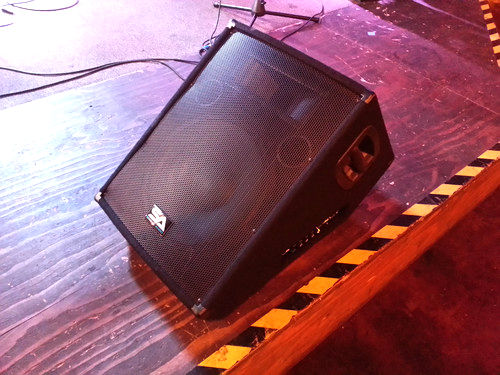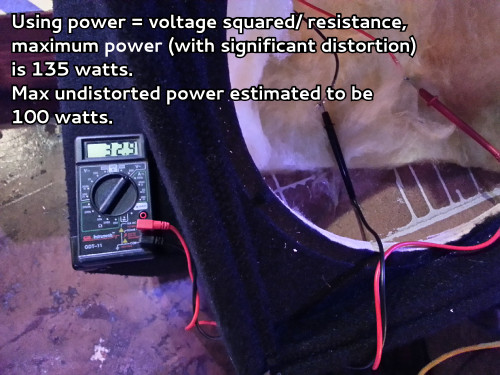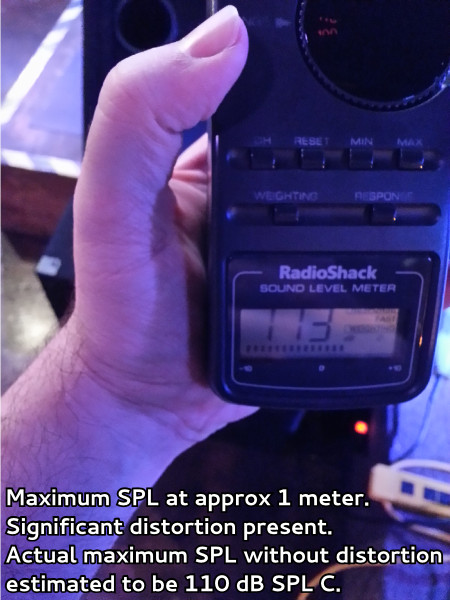You won’t be let down if you’re not asking too much.
Please Remember:
The opinions expressed are mine only. These opinions do not necessarily reflect anybody else’s opinions. I do not own, operate, manage, or represent any band, venue, or company that I talk about, unless explicitly noted.


I have a weakness for “upstarts.”
I love to find little companies that are doing their own thing and trying to have some kind of fresh take on this business. When I ran across Seismic Audio, I got a little infatuated with ’em. Here were some audio-gear humans that were doing something other than selling everybody else’s boxes. Here were some folks who had some interesting, hard to find, “nifties.”
Seriously – maybe I just wasn’t looking hard enough, but Seismic had a reel mounted, 8 send/ 4 return snake with 50′ of trunk when nobody else did. And it was the perfect thing for what I needed at that moment. Neat!
Anyway.
Of course, when you’ve been at this kind of thing for a while, you develop a sort of BS detector for sales. You look at a page that’s trying to get you to buy equipment, and you instinctively throw out all the numbers and claims that you think are “best case scenarios.”
What other people call, “horrific, crippling cynicism that threatens to poison all joy and blot out the sun” is what I call “being realistic about what the sales guys are saying.” (Welcome to the music business, boys and girls!) With a company like Seismic, my thought process goes like this: “These guys have some neat offerings, and the prices are quite low. In order to do that, they must be saving money somewhere. I should expect that some part of these products is going to be demonstrably ‘cheap,’ and not be disappointed when I discover that part.”
So – when it was time to buy some new monitor wedges (because half of the current set had committed full or partial suicide), I decided to take a chance on Seismic. My goal was to get some boxes that would be “enough” for a small stage, and not to worry about having varsity-level build quality or performance. The gear wouldn’t be moving around a lot, and the bands I work with are good about not abusing monitor wedges, so I was confident that a “middle of the road” unit from Seismic would work out.
Trying Not To Ask Too Much
As I looked around Seismic’s site, I found myself gravitating towards the SA-15MT-PW monitors. Because of their configuration, which puts the HF (high frequency) driver above the LF cone, they would be naturally “bookmatched” (vertically symmetrical) when operating in pairs.
In the absence of a specific claim one way or another, and at the box’s price point, I was very sure that the 15MTs were neither biamped nor equipped with fancy processing. I would essentially be receiving passive monitors that had an amplifier and input plate added. I was perfectly okay with this.
I hoped that the 15″ driver would provide an overall output advantage over a 12″ unit, especially since I just decided to not care about anything below 75 – 100 Hz. In an environment like the one where I work, using the onstage monitoring rig to create thundering bass and kick is not a priority. The monitors are mostly there for the vocalists, with instrument midrange as an added bonus.
Seismic’s site claims that the box will play down to 35 Hz, but let’s be real. Making 35 Hz at “rock show volume” is hard enough with a properly built “mid-pro” sub, and 15MTs are affordable drivers in a small box. I’m sure the LF cone will vibrate at 35 Hz, but you’re not going to get much usable output down there. See? Being cynic – ah – REALISTIC is good for you.
I’ve also become very good at ignoring “peak” numbers in power ratings. Whenever you see “peak,” you should mentally change the wording to “power that’s not actually available to do anything useful.” What you really want to find is the lowest number with “continuous” or “RMS” next to it, and assume that’s what you’re going to get. SA claims that their powered 15MT units have an amplifier that’s capable of 350 watts continuous. I think this may be an increase from when I was shopping, as I remember something more along the lines of 250 watts.
What I was most prepared to accept was the published sensitivity rating and maximum SPL. With one watt (actually, 2.83 VRMS, but that’s a whole other discussion), the boxes were supposed to be capable of 97 dB SPL, continuous. The maximum SPL was listed as 117 dB SPL.
This seemed pretty reasonable to me, and here’s why: With a 97 dB sensitivity, 250 watts of continuous input should get you into a calculated maximum SPL range of 121 dB. That they published a maximum number LOWER than that (117 dB) made me feel more comfortable. Seeing a number that suggested that the driver could only really make use of half the available continuous power reassured me. This isn’t actually strange – when you see a number that is below the theoretical maximum, it gives the impression that the boxes were actually measured as being able to hit that number.
I thought to myself: “If I put two boxes together, I can get 120 dB SPL continuous out of the pair. That’s enough for our stage. If somebody wants more than that, then they’re playing the wrong venue. I’m going to order these.”
I got free shipping and a discount. That felt pretty good.
A Short Honeymoon
When the 15MTs arrived, I was encouraged. They weren’t too heavy, and you could actually lift and carry them in a not-awkward way by using the handles. I wasn’t wild about the way that an XLR connector would stick out of the side-mounted control panel when everything was connected, but I’m pretty much convinced that getting a powered speaker’s input panel to be perfect is an impossibility. I tried the boxes with a bit of music, and the sonics seemed fine. The playback was clean, and the overly present (too much high-mid) timbre of the boxes was easily tamed with the onboard EQ – which is a good sign, because if simplified, broad-brush EQ can fix an issue, then the problem isn’t really bad.
The units were put to work immediately in a festival setting. The venue was hosting an annual showcase of local talent, and this seemed like an ideal way to put the monitors through their paces. They’d need to perform at both quiet and moderately loud volumes, and do a lot of different acts without a hiccup.
The first day went by without a problem.
The second day wasn’t so good.
The high-energy point in the night was being provided by a band with strong roots in both country and rock. Even in an acoustic setting, this part of the show was meant to be pretty “full tilt” in terms of feel and volume. I got the lead singer’s vocal switched up to the necessary level – and that’s when I noticed the problem.
The 15MTs were distorting, and distorting so audibly that the “crunch” could clearly be heard through the cover that FOH (Front Of House) was providing. I was very, very embarrassed, and made it a point to approach the lead singer with an apology. I assured him that I knew the sound was unacceptable, and that I wasn’t just ignoring it.
He was very gracious about the whole thing, but I was not happy.
Oversold On The Power
With what seem to be updated specs on the Seismic Audio site, I can’t be sure that the SA-15MT-PW units currently being sold are the same as the 15MTs that I was shipped. What I can say, though, is that the units I was shipped do not appear to meet the minimum spec that was advertised at the time.
Not the hyped specifications – like I said, I ignore those as a rule – the MINIMUM spec was not achieved.
I’m about 90% sure that I’m right about this. The 10% uncertainty comes from the fact that I don’t exactly have NASA-grade measurement systems available to me. I can’t discount the issue that significant experimental error is probably involved here. At the same time, I don’t think that my tests were so far off as to be invalid.
After empirically verifying that sufficient volume with a vocal mic caused audible distortion (and at a volume that I felt was “pretty low”), I decided to dig deeper.
I chose a unit out of the group, removed the grill, and pulled the LF driver out of the enclosure. I then ran a 1 kHz tone to the unit, and increased the level of that tone until I could clearly hear harmonic distortion. The reason for doing this is that, for a single-amped box equipped with a 1″-exit HF driver, 2+ kHz distortion components will be audible in the HF section without being incredibly loud. The small HF driver is probably crossed over at 2 kHz or above, so the amp going full-bore with a 1 kHz input is unlikely to cook the driver.
Having found the “distortion happens here” point, I then rolled the test tone down to 60 Hz. My multimeter is designed to test electrical outlets in the US, and that means that its voltage reading is only likely to be accurate at the US mains electrical frequency of 60 Hz. I connected my multimeter’s probes to the LF hookup wires, and got this:

As the image states, 32.9 volts squared over 8 ohms (the advertised nominal impedance of the drivers in the unit) works out to be 135 watts…and that is with VERY significant distortion. In general, when an audio manufacturer claims a continuous or RMS power number, what that means is the unit can supply that power without audible distortion. In this case, however, that didn’t hold.
To be brutally frank, if this measurement is correct then there is NO PHYSICAL WAY that the units I was shipped have 250 watts of continuous power available, with the peaks exceeding that number. You might be able to get 250 watts continuous out of the amp if you drove it as far as possible into square-wave territory, but you wouldn’t want to listen to anything coming out of the monitors at that point.
Oversold On The SPL
After reconnecting and reseating the LF driver, I ran pink noise into the unit at the same level as the test tones. I then got out my SPL meter, and guesstimated what 1 meter from the drivers would be. Here’s what I got:

If the claimed maximum SPL was 117 dB, then this is actually a pretty consistent reading with the box only being able to do about half of what was advertised. Even so, this number was generated by a unit that was beyond its “clean” output capability.
Now – again – let’s be very clear. I can only speak about the specific units that were shipped to me. It would be wrong to say that these results can be categorically expected across all of Seismic’s product lines. It would also be wrong to say that the 15MT-PWs being shipped today are definitely the same design as what was shipped months ago. Products can change very fast these days, and it may be that Seismic has upgraded these units.
I also want to be clear that, dangit, I’m rooting for Seismic Audio. I love scrappy, underdog-ish businesses that carve out a space for themselves. Heck, maybe a parts manufacturer sent them the wrong amplifier plates. Maybe the passive versions of these boxes (and every other speaker they sell) meet the minimum spec. The only way to know would be to buy and test a sample of everything.
Still, in this particular case, the products I was shipped did not live up to what they were advertised to do. They’re not useless by any means, but they can’t quite cover the bases that I need them to cover. I’m planning on finding them a good home with people who can actually put some miles on ’em.
…and, Seismic folks, if you read this: I don’t want my money back, or I would have asked when I still could. I do want you guys to keep doing your thing, and I also want you to be vigilant that the products you ship actually meet the minimum spec that you list on your site.